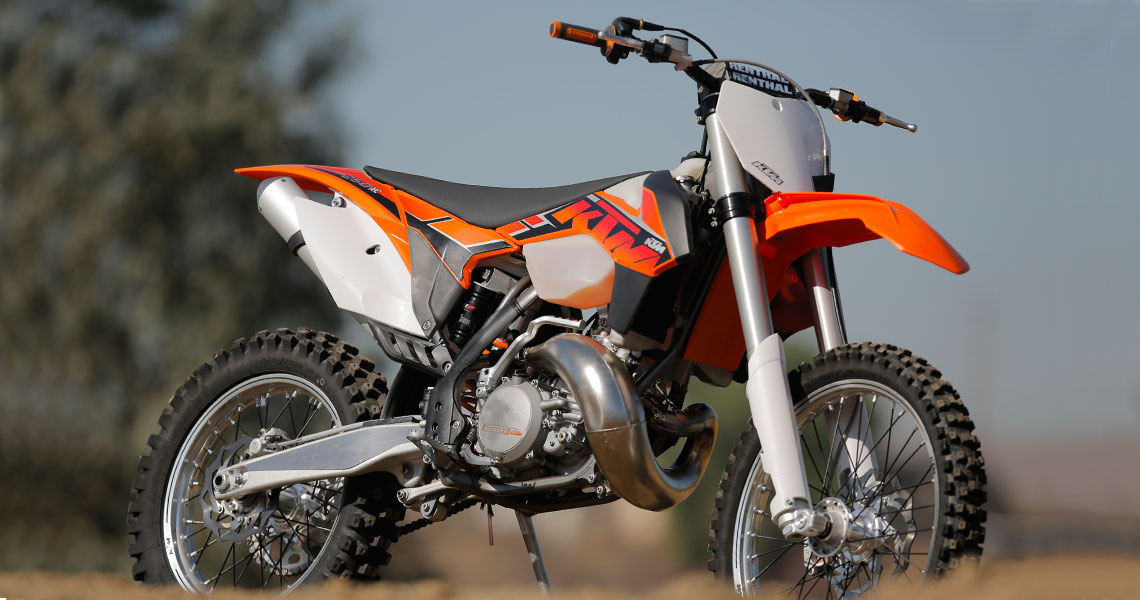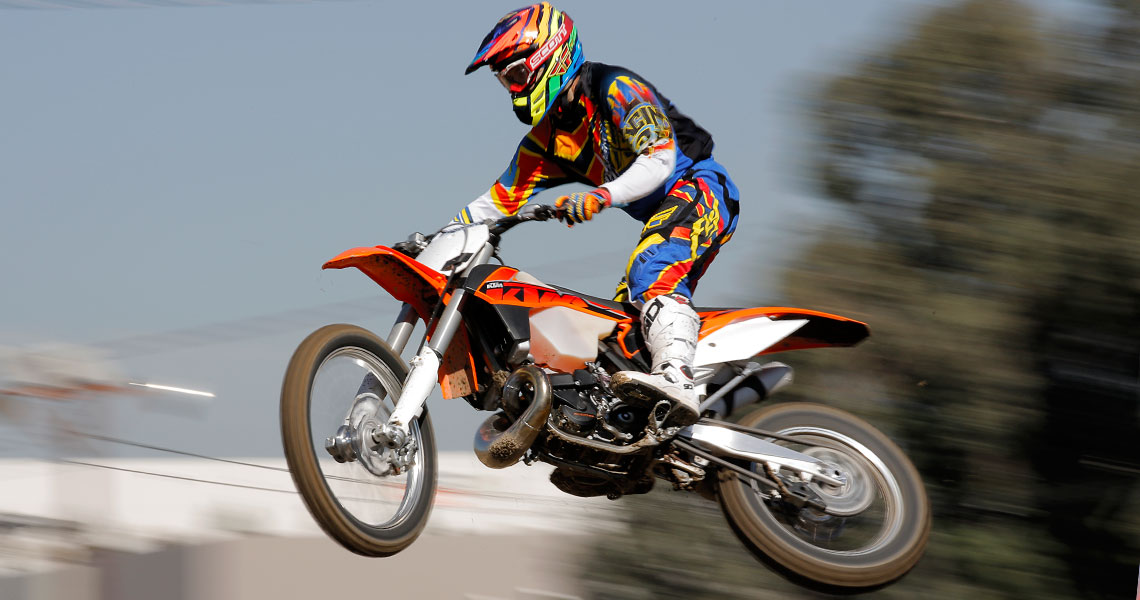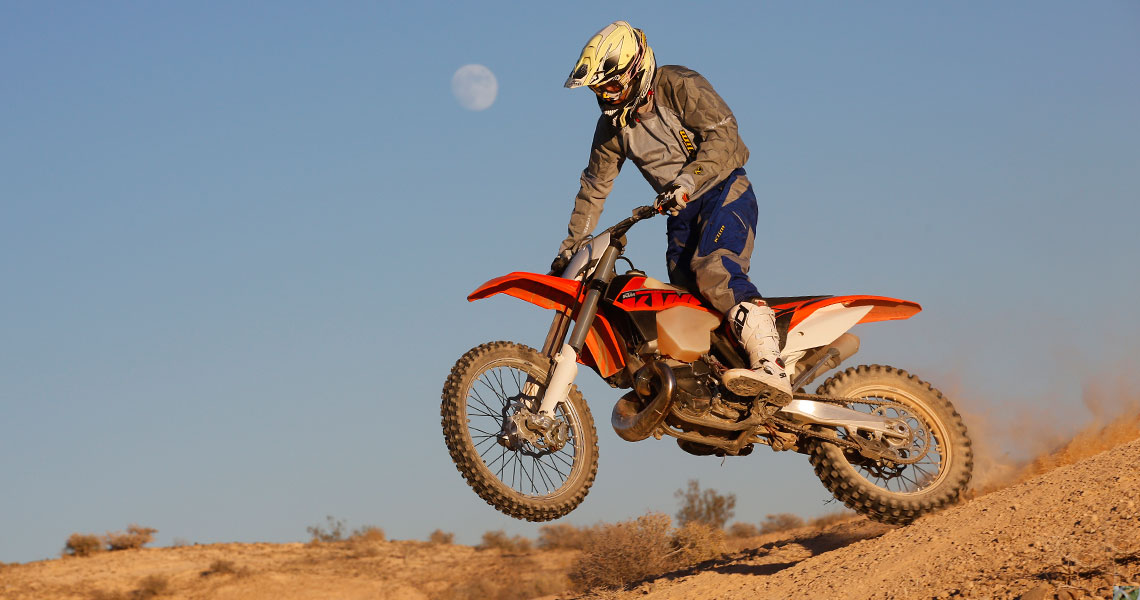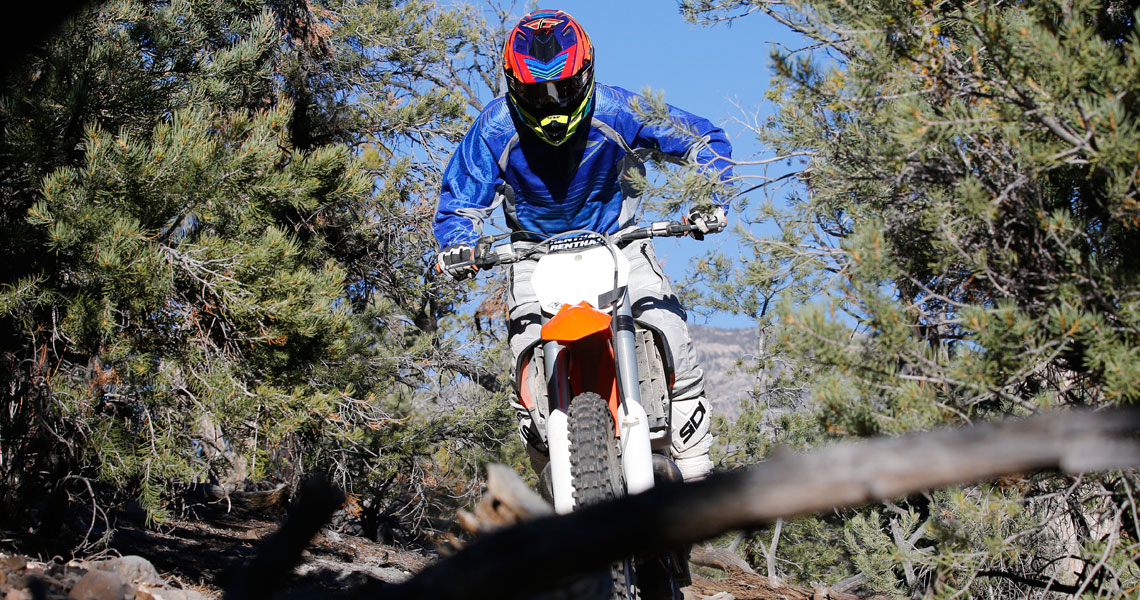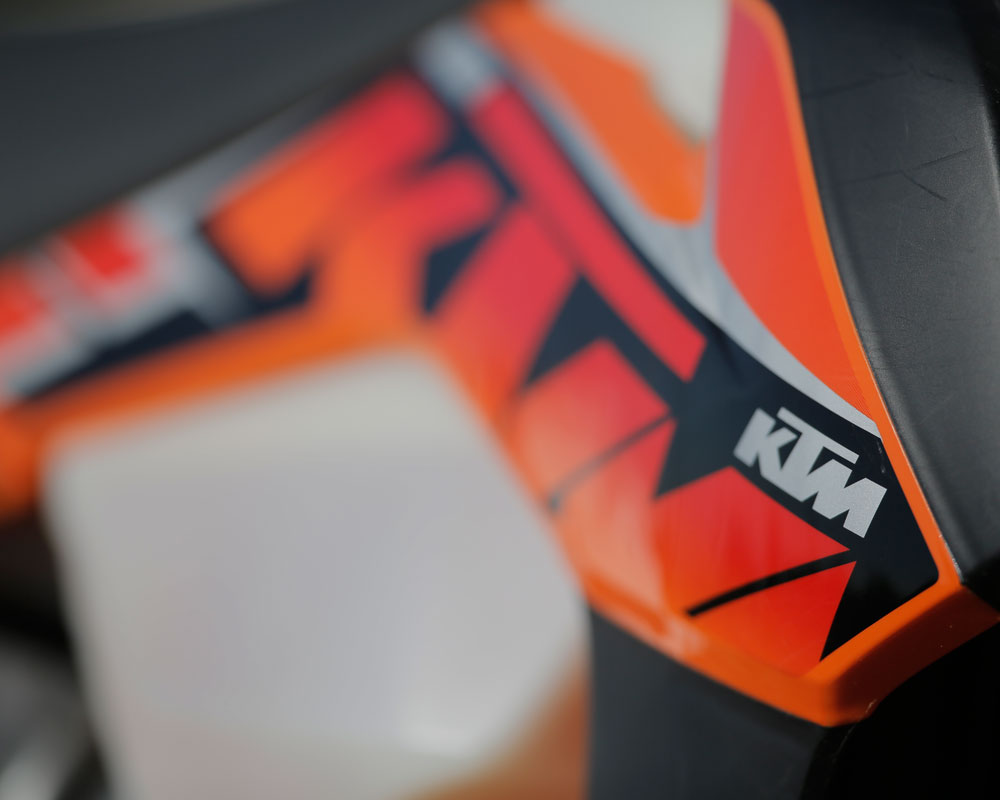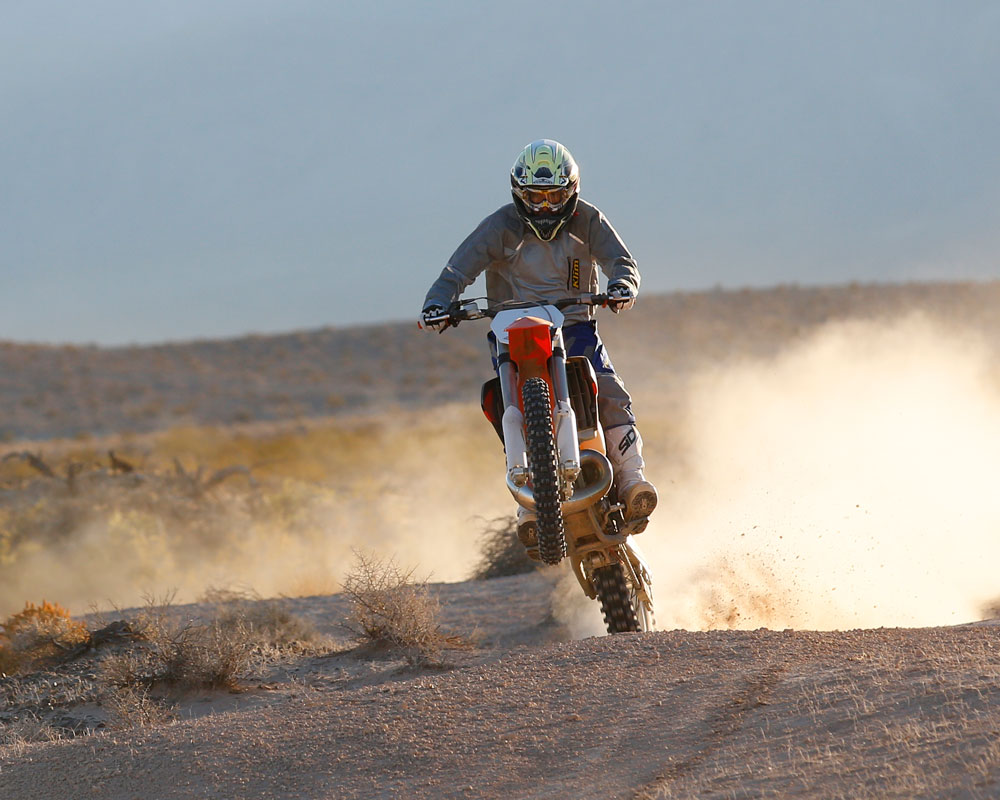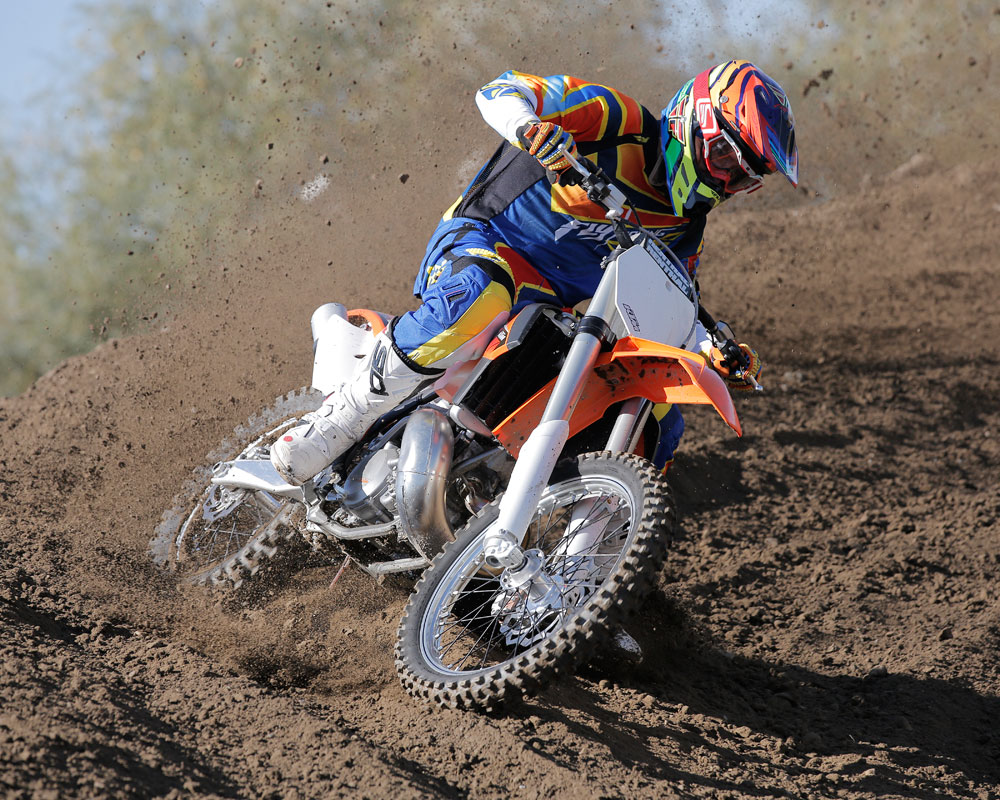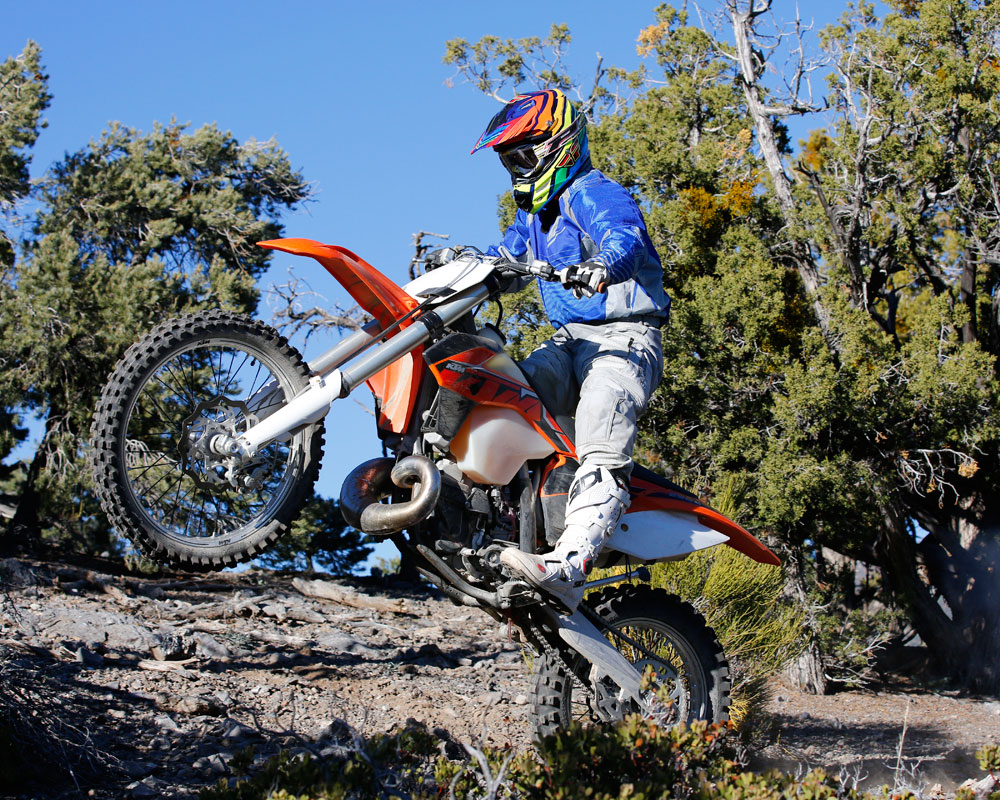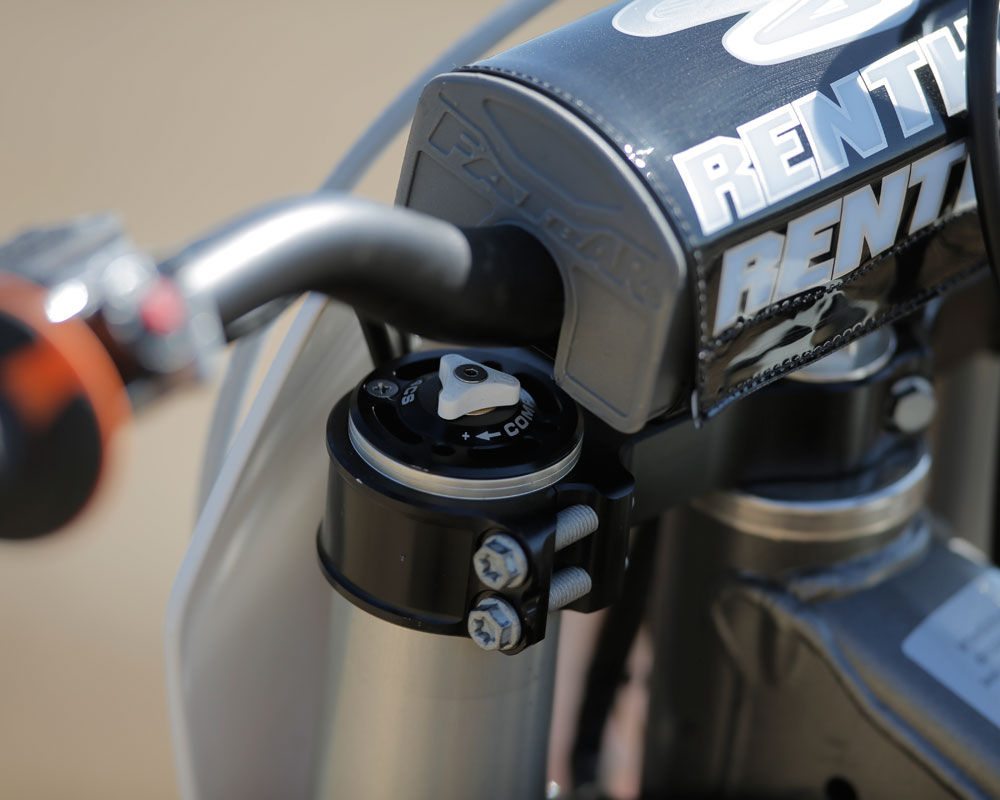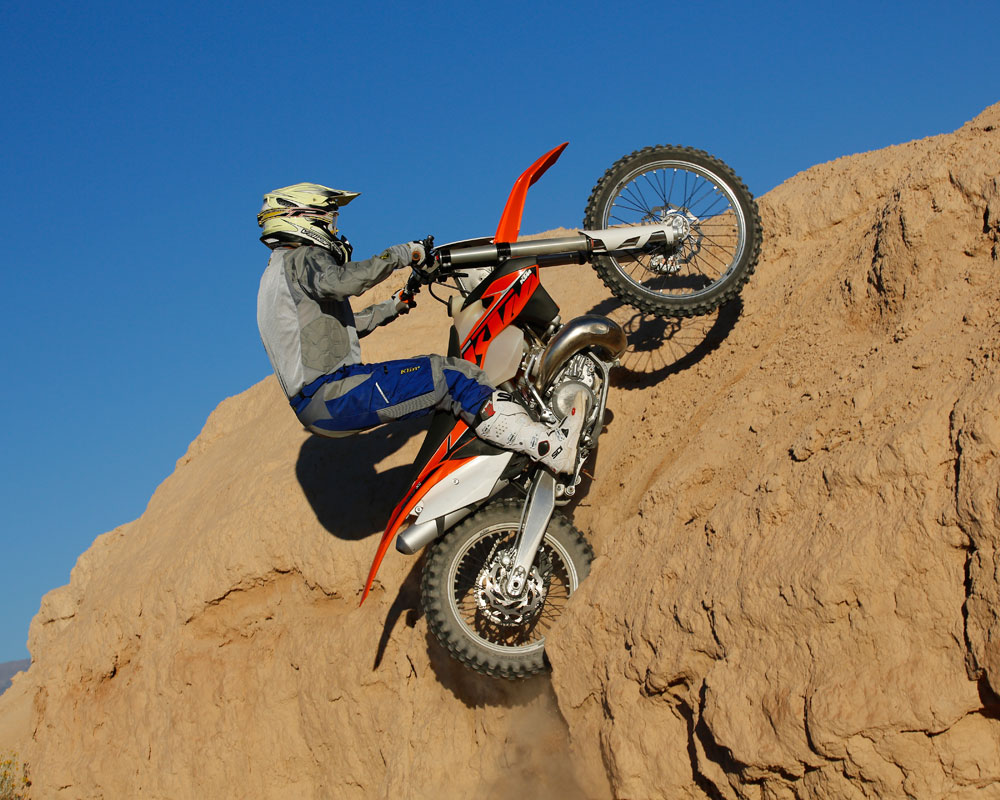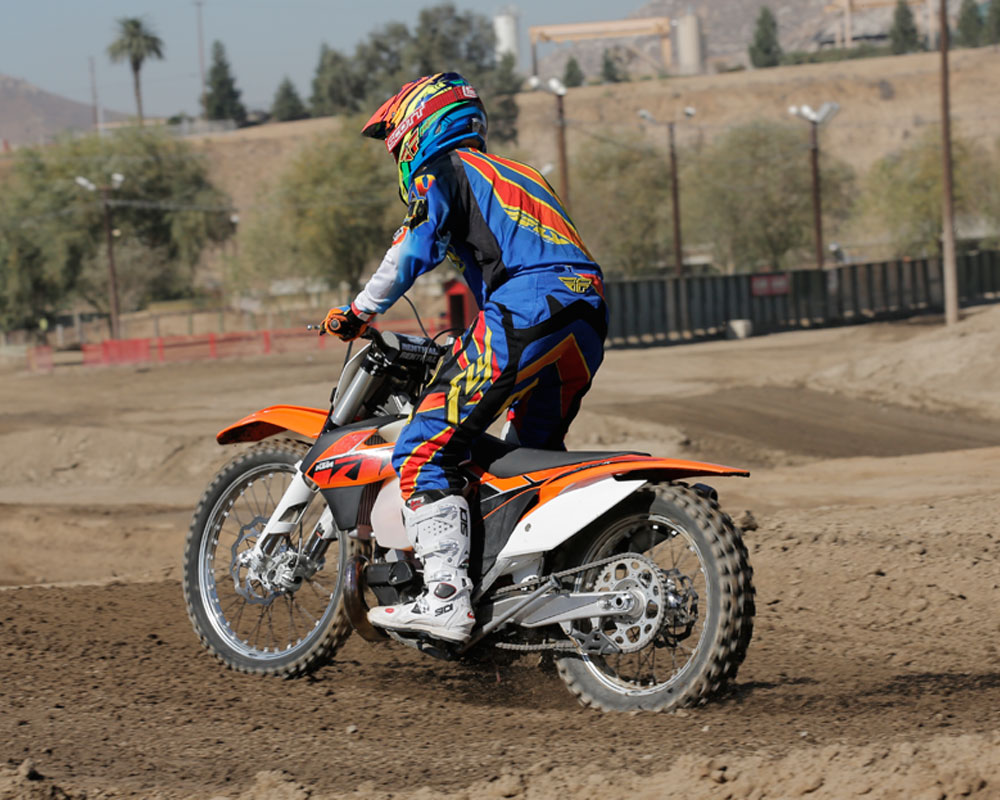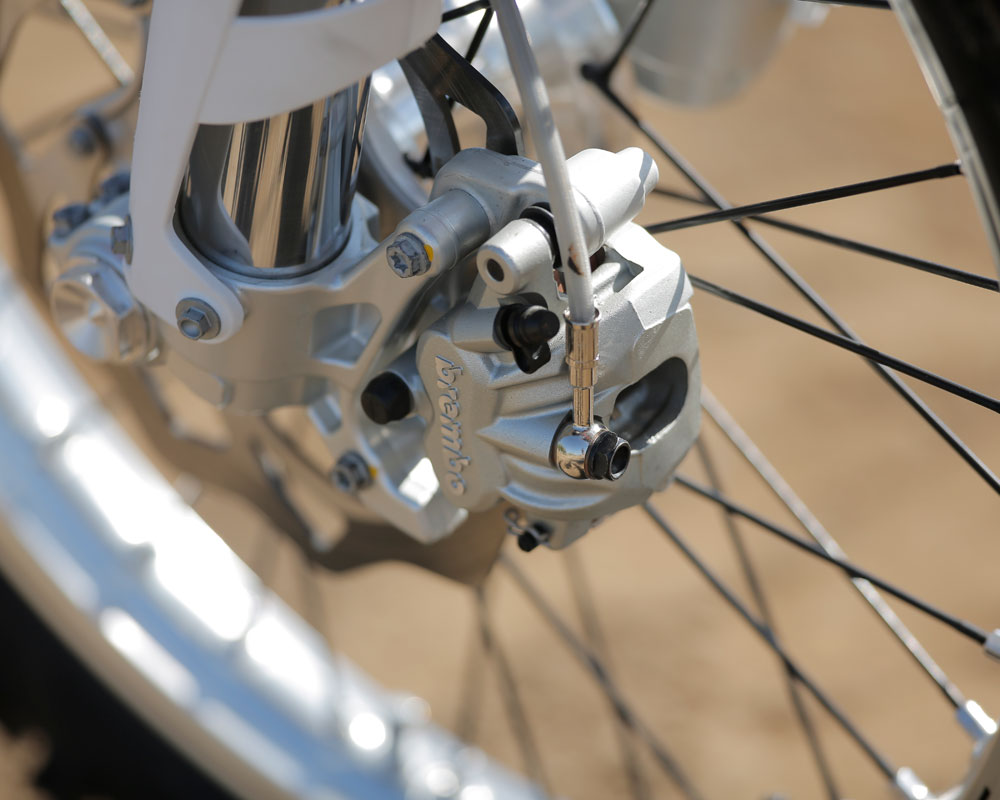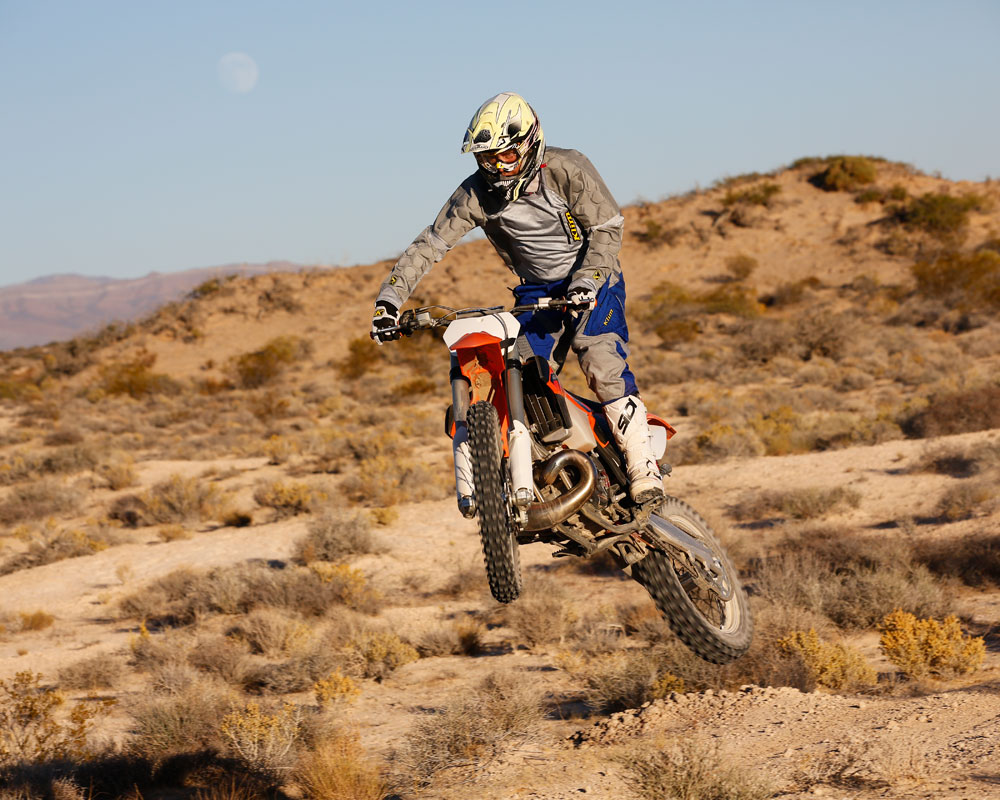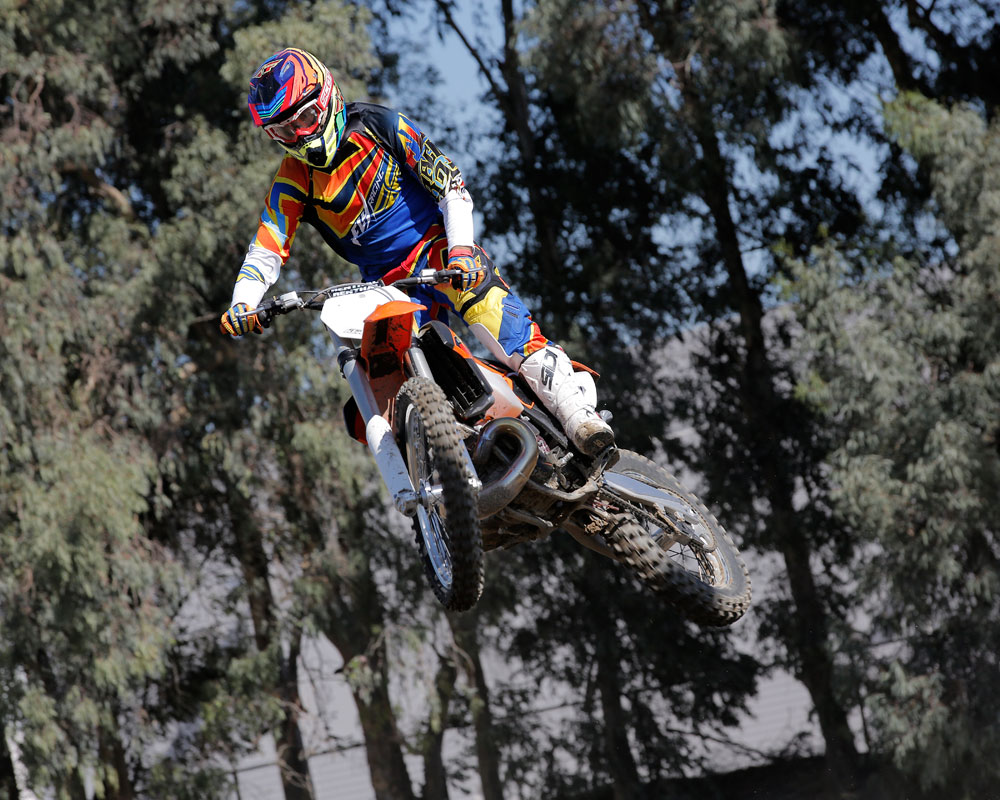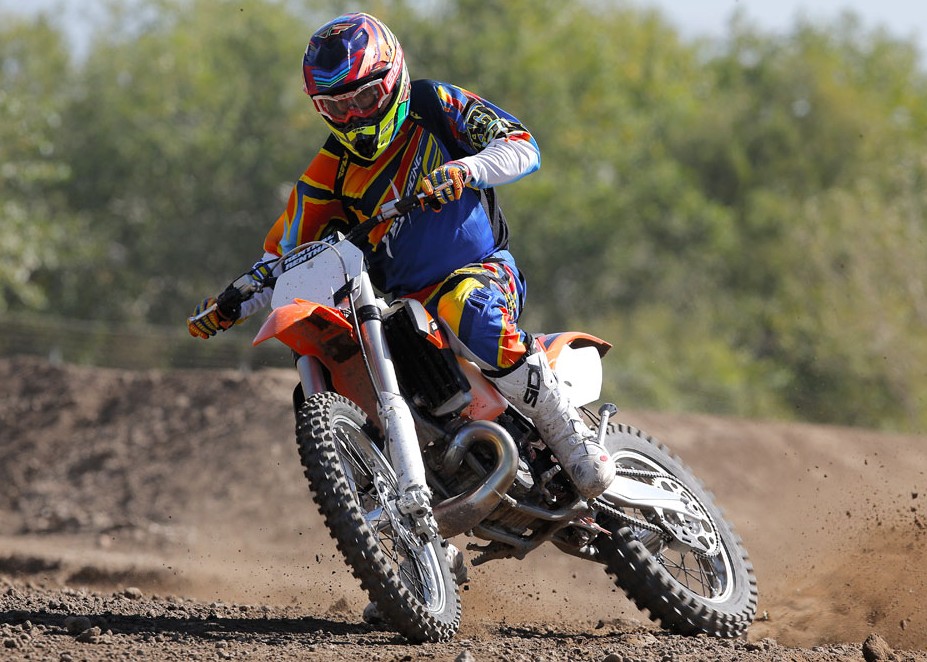2014 KTM 250 XC
Jack Of All Trades?
MSRP: $8299
- Electric start two-stroke.
- Tractable--almost three-stroke power.
- Better than a 300 in light-weight feel, peppiness in the engine and running in the upper revs.
- Takes on moto, off-road, and trails in a single twist of the throttle.
- Suspension can be too stiff and too soft, depends on where you are and what you expect.
- Front end pushes a tad at lower speeds off-road.
- Seat could be slightly softer for off-road/trails, especially at the back.
Introduction
- Light and agile two-stroke.
- The performance almost feels like we were riding a three-stroke.
- Electric-Start saves the day.
- Three days from the track to the desert to the woods
The age-old question, can one motorcycle do it all—and do it well? Back in the day, every house had a bottle of 3 in one oil, their claim was it did it all. Can the KTM 250 XC make that claim? When it comes to motorcycles we often face a similar dilemma and this is why most of us motorcycle addicts often have several bikes in the stable, or simply choose one and struggle with handling or performance when crossing over to different venues or riding areas.
KTM serves up a literal cornucopia of off-road motorcycles—you name it, they make it—moto, off-road, desert/grand prix, dual sport, adventure, and in Europe, a freeride extreme enduro/trials bike. Also pick a stroke, two or four.
Our quest was simple; find a do-it-all scoot without compromising too much. Yes, you can take your enduro bike to the moto track, but the power is soft and the suspension even softer. And vice versa when it comes to taking a full moto bike to your favorite, tight, single track up in the woods—often too fast and way too firm. We all yearn for a light, flickable motorcycle for the tight woods; stability and firm suspension for the moto track; and a bike that can blitz through 5 miles of sand desert whoops, all in one shot. And if the 250 isn't enough they make a 300cc version, just in case.
The KTM 250 XC is Katoom’s closest answer to this quest, much like all-in-one shampoo/conditioner is to hair care products. The 250 XC is based off the SX motocross version with several revisions/changes. The tranny has a wider ratio 6-speed gear box, the rear wheel is 18-inches, the engine is tuned for more torque and tractable power, and the suspension is softer than moto settings but firmer than its full off-road XC-W brother using a linkage out back. Unlike the XC-W, the XC does not come with any lights, but the wiring is there just in case. And compared to the SX, the best feature of all is the electric start. Also, the oversized 2.6-gallon fuel tank is great for longer rides.
Changes
- New WP 4CS front fork set up specifically for the XC.
The big change for 2014 is the fork. It comes with the WP 4-Chamber 4CS fork, valved specifically for off-road. This is the same fork that comes on the 2014 Factory Replica SX-F 450. Compared to the XC-W, the XC and the SX have a linkage rear suspension compared to the W’s PDS, and a beefier chain guide for '14 with a revised setting to reduce bottoming. The front brake has a smaller piston for a little more power combined with a new brake pad material. The bodywork has some new pieces including the reinforced front fender. Inside the engine there is now a Boyesen reed cage and a DDS single spring clutch for a claimed more consistent feel with a lighter pull.
Power
- Ample performance to take on pretty much any motocross track.
- Amazing low-end torque puts the power to the ground.
- Very easy to ride.
Those who have experienced the differences between a higher strung 250 two-stroke motocross bike and an easier to ride four banger will welcome the performance of the KTM 250 XC. You can almost call it a three-stroke. It really combines the entertainment of a two-stroke and the broad tractable power of a four-stroke. There were minor updates to the mill for 2014 including the use of a Boyesen reed block and reeds, ignition updates, as well as head squish band shape change to improve responsiveness while retaining a broad power curve.
The XC’s power delivery crosses over very well from moto to off-road. It pulls from a lot lower than you'd think and really lacks that snap or burst older two-strokes were known for. We even compared it to a stock Yamaha YZ250 on the moto track and the differences were pretty amazing. While the YZ revved super fast and hit a lot harder, the YZ was difficult to ride compared to the amazing long-pulling torque and performance of the XC, which just puts power to the ground better. The XC’s performance is more controllable compared to the two-strokes of yesteryear, yet it still has all of the attributes one would enjoy from a two-stroke, mostly the simplicity of the whole thing. Plus you can further adjust the hit and the power slightly via the adjustable power valve, which is an added feature.
The XC does not rev as high on the moto track as first expected but once you adjust your style to trust the amazing torque down low, you are back in business. Quicker shifts tend to pay off, yet the sign-off is plenty long off the top end.
The clutch pull is very light and has great feel. It takes tons of abuse and fades very little. On tight trails or in the open desert, the responsive torque will lug down to climb slippery rock sections as well and loft the wheel through desert sand whoops if needed. Compared to the 300cc version of the same bike, the 250cc is peppier on the bottom, yet it does not feel as if it revs out as much as it used to in comparison.
The 250 XC is a workhorse and offers ample power to launch any jump at a local moto track with confidence yet still chug like a billy goat on the tight trails, with stock gearing. Yes, a slight gearing change might be called for if you ride a lot of moto or are heavier, but that is really contingent on the rider and their needs. In stock form it performed pretty swell in all conditions and favors the more aggressive rider compared to a 300. Shifting is flawless as well.
Suspension
- The initial firm suspension feel worked well on the moto track.
- Off-road the fork is too stiff at first and can blow through the stoke on g-outs and whoops for aggressive riders.
KTM is asking a lot of the suspension on this bike by saying it can do anything. And of all the bikes out there, there are few with this much versatility. Trying to get suspension to work at several tracks can be a task but to get it to work across the board from moto to off-road to tight trails is a difficult trick.
Overall, the fork and shock are very balanced, yet by the end of our trifecta test the overall performance was a split decision. On the first day of testing at the moto track, we found the valving had an initially firm feel, especially the fork, which worked very well for this dirt du jour. It didn't feel as much of an off-road bike as we had first expected.
We rode more of a jump-filled track with some chop, but no real big g-outs, whoops and the track stayed in fairly good shape all day. The rebound was a tad too fast initially but nothing that couldn't be fixed with a few clicks on the shock. Knowing the XC is not a full moto bike, we expected the latter part of the suspension stroke to be softer with slightly less bottoming control, which it was, yet plenty capable of taking on the track.
When we headed to the desert and tight trails, we noticed the firm initial feel and the softer latter part of the suspension stroke was not as accommodating as it was on the moto track. We did improve the feel with clicker settings to allow the fork to soak up the small bumps and chop off-road, but that also caused the rest of the stroke to soften up and sometimes blow through in desert whoops or g-outs, especially the fork. And in the tight woods, the fork was manageable but still a little firm at slower speeds and did not offer enough front wheel feedback and tire grip in some conditions.
It was far from bad, it just felt like the settings accommodated moto and grand prix tracks more than desert and tight trails. If we had more time on the bike we would have tested raising the fork oil height to allow us to back off the fork compression even more, though the tuning of the 4CS fork is a bit different than what we are used to and the compression and rebound damping clickers have less influence on the initial movement of the fork than we were accustomed to. Off-road the suspension is a tad too firm initially and then slightly too soft toward the end, especially in the open desert.
Overall the setting is about as good as could be expected for a bike tasked with doing so much, and nails what we'd set the bike for if racing a grand-prix style event as long as the track were not crazy rough. A little more progression, especially off-road, is about all the could be improved.
Chassis - Handling
- Very light feeling chassis.
- Comfortable ergonomic feel for average riders.
What can you say about a light 250cc two-stroke? They are easy to ride and confidence inspiring. The XC feels like a moto bike and the oversized fuel tank does not really inhibit the feel and lightness of the motorcycle. Some hard-core KTM trail riders are still on the fence whether the rear link is any better or worse than the tried and true PDS system on the XC-W. A lot of that boils down to setup and what the rider is looking for. The only real downside to the link is that it can get held up in extreme rock sections or tree hopping.
The XC is a stable bike and crosses over better than pretty much any bike on the market. It is not easy to find a ride that is as manageable when taken from the track to tight trails then back to the desert floor.
The chassis seems to accommodate a variety of riders from 5' 8" to 6'. Taller riders wanted a little more seat-to-peg distance and shorter riders wanted less. KTM and others offer several seat height combinations to rectify these issues and the handlebar mount has four different positions. The XC is easy to move around on and there are no hang-up points on the bodywork. Steering is very light through the handlebar. The only comments were some test riders did notice the front-end feel/grip was more solid on the track but a little vague and almost too light on the trail, especially when compared to another 250 two-stroke off-roader during our testing phase.
The front end pushed a little in dry soil and some riders had to steer the bike a little more with the rear tire and the bike’s power than they would have liked. This even after playing with the ride height--we didn't want to lose any of the stability to gain improved turning. At speed it was not as much of a factor as it was at slow speeds, if the fork would have pushed a little farther into the stroke, maybe this would be an issue.
Overall the chassis is very accommodating in nearly every condition and seems to take less energy to ride in most conditions, compared to larger four-strokes. Additionally the motor is so sweet it makes the bike work that much better underneath you, only helping and never getting out of hand.
Conclusion
- Easy to ride performance with a light flickable chassis.
- The more you hit the track, the more the 250 beats out the 300. Think aggression.
- Awesome brakes, electric start and easy pull clutch.
So is the KTM 250 XC the answer to peanut butter and jelly all in one jar? The answer is yes and no. No, it is not the best moto bike, nor is it the best off-road or tight woods bike—we have ridden better. However, it’s hard not to love the utilitarian prowess of the XC. Most of us can’t afford to own three different motorcycles and riding a moto bike off-road can be torturous and beats the heck out of you, yet riding your enduro bike at the moto track can be downright dangerous if you plan on heading to the main track (not the vet track). The XC kind of does it all and does everything pretty well. Ya gotta love the electric start, the lower cost to maintain a two-stroke, the light and easy-to-ride chassis, amazing brakes, easy pull clutch and the durability of a KTM. You don't have to switch gas tanks for any condition and the XC (not ours for some reason) even comes with hand guards. The Orange brigade has done a stellar job trying to create an amalgamation of all things dirt bike, two-stroke and four, moto or trail, to create the do-it-all 250 XC.
Recent Product Tests
What Others Said

http://www.dirtrider.com/features/five-bike-six-hour-race-test/
Rider Opinions
Leave a Reply
